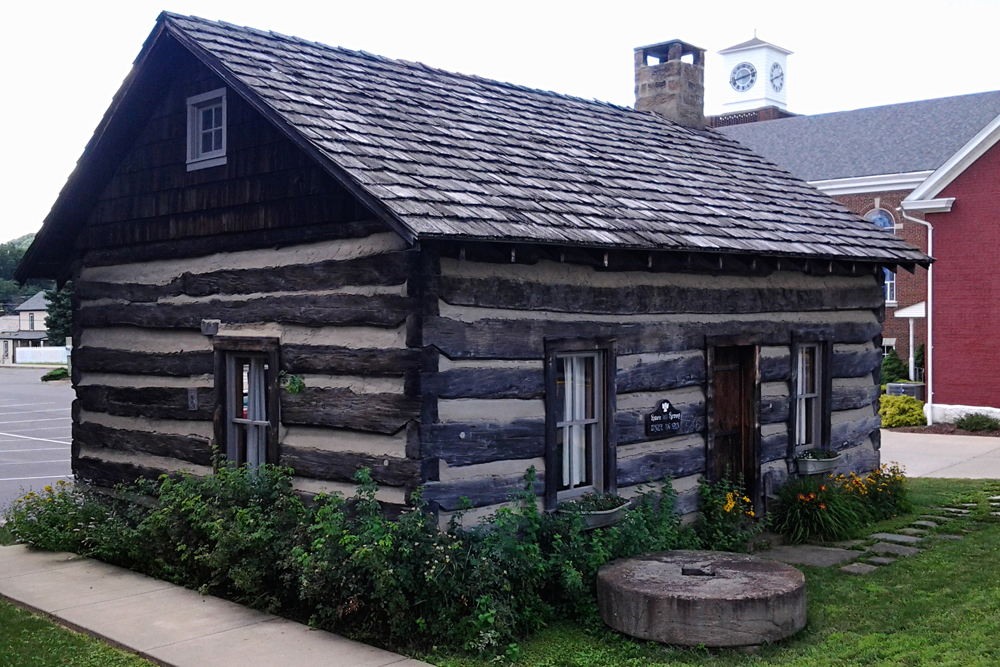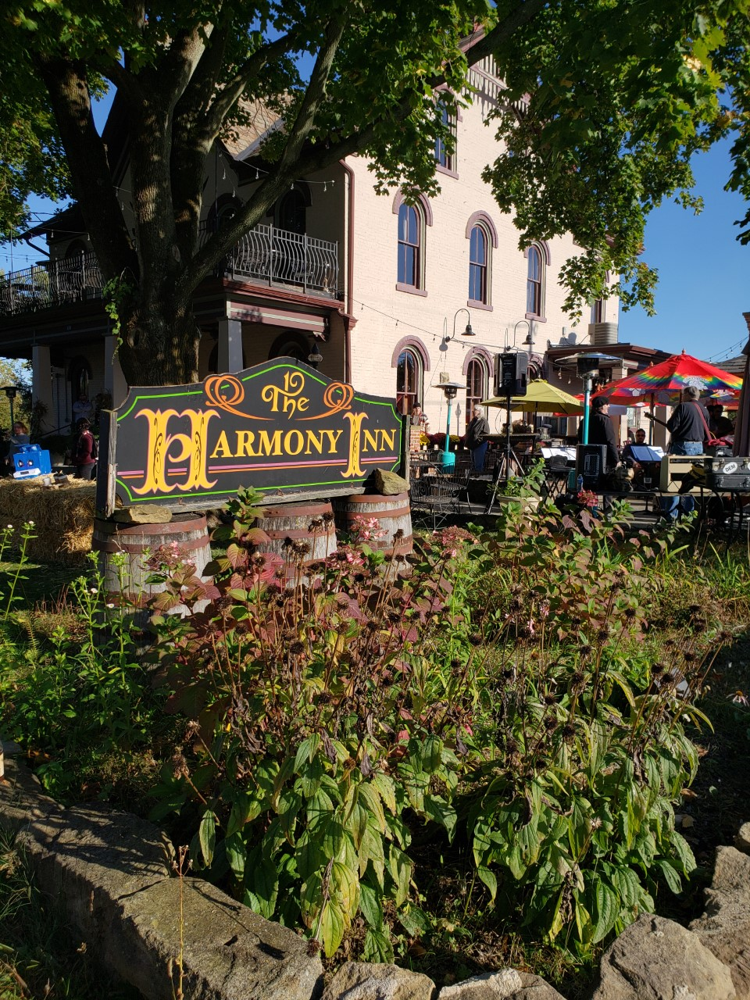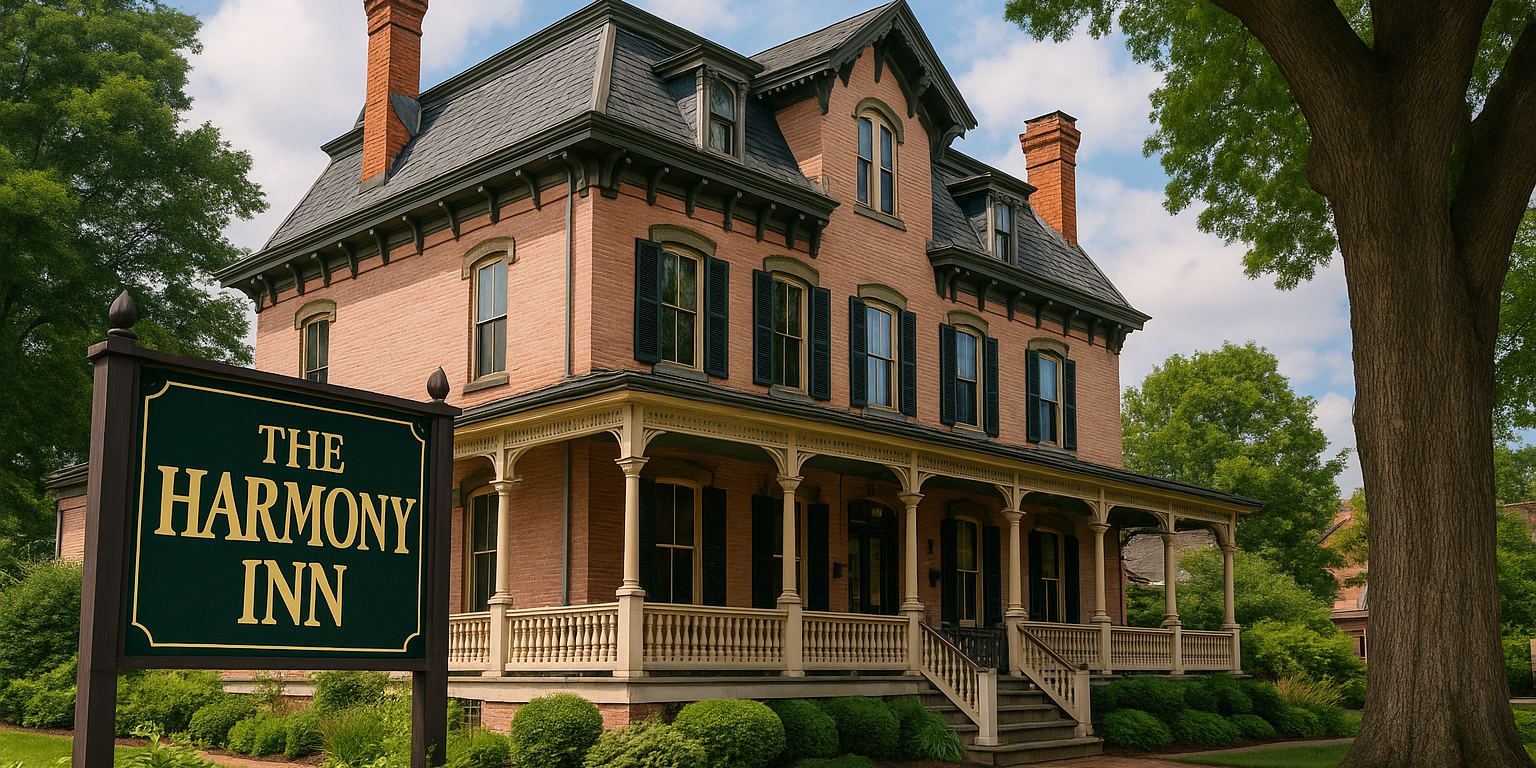Introduction: Frontier Faith and Fear
In the early 19th century, the dense woods of Western Pennsylvania held more than just wild game and frontier homesteads. They held secrets and stories. The tiny village of Harmony, PA—founded by a band of mystic German settlers—was a place where utopian dreams met old-world superstitions. Long before ghost tours and Halloween tales, Harmony’s very ground was steeped in legend. In fact, decades before the town was founded, George Washington himself nearly met his end nearby. In 1753, while traveling these trails, a Native guide turned on Washington and fired a musket at him at point-blank range . The shot miraculously missed. Locals like to say this was “the first shot of the French and Indian War,” and that Washington’s survival was an omen that this land held powerful providence . It’s in this aura of destiny and mystery that the story of Harmony unfolds – a story of fervent faith, whispered witchcraft, and enduring folklore.
Washington’s Brush with Death & Frontier Superstitions
Years before Harmony was established, the surrounding frontier already had a reputation for the eerie. After Washington’s narrow escape in 1753 , settlers passing through the area spoke in hushed tones about the wilderness’s dangers – both real and supernatural. The frontier bred superstitions as readily as it did corn and cattle. In the late 1700s, Western Pennsylvania pioneers carried Old World beliefs about witches and curses. One notorious tale from nearby Butler County involved “Mother” Ann Girty, wife of frontiersman Thomas Girty. Ann was an herbal healer, but fearful neighbors branded her a witch – a label that proved deadly. In a grim episode of frontier justice, Ann Girty was murdered by an intruder in her cabin, her fate sealed by rumors of sorcery . For years after, local children dared not pass the Girty homestead at night, convinced her restless spirit lingered. This was the cultural backdrop into which Harmony was born: a place where faith in God vied with fear of the devil in the woods.
Founding of Harmony: A Utopian Experiment
In 1804, a very different kind of settler arrived in this enchanted valley. Johann “George” Rapp, a charismatic German pietist, led some 90 families into the Pennsylvania wilderness, seeking sanctuary from religious persecution . They pooled their resources and, on February 15, 1805, formally organized the Harmony Society, pledging to hold all property in common . Rapp’s followers – called Harmonists or Rappites – set about carving a community out of the forest. Through hard work and a shared divine purpose, they thrived. By 1807, Harmony boasted neat log houses, barns, workshops, and even a brewery and tannery . The commune soon numbered around 800 to 1,000 members, with 2,000 acres under cultivation and over 100 buildings erected . This prosperity was startling on the rough frontier. One nearby settler remarked that the Harmonists’ industry transformed the wilderness “as if by magic.” Indeed, to outsiders the society’s success felt almost supernatural – a testament either to God’s favor or some strange trickery, depending on who you asked. But inside Harmony’s boundaries, the true source was no mystery: it was faith, discipline, and community.

A surviving Harmonist log house (now part of the Harmony Museum) exemplifies the solid timber construction of the Society’s early 1800s settlement. The simple architecture belies the profound faith and communal spirit that built Harmony out of the Pennsylvania wilderness.
George Rapp: Prophet of the New World
Harmony’s founder, George Rapp, was no ordinary pioneer. A weaver and wine-grower by trade, Rapp was also a self-proclaimed prophet with a mystical bent. Back in Germany around 1790, he had openly declared, “I am a prophet, and I am called to be one,” an act of defiance that got him jailed by local authorities . Inspired by radical pietist thinkers like Jakob Böhme and Emanuel Swedenborg , Rapp preached that the Second Coming of Christ was imminent. To prepare, his followers must separate from corrupt society and live in strict Christian unity. In Harmony, Rapp’s word was essentially law. By all accounts he was a “strong personality” – a tall, bearded patriarch often described as charismatic and commanding . He urged the Harmonists to embrace pacifism, hard work, and celibacy, believing worldly pleasures only distracted from the coming Millennium . Yes, celibacy – despite many members being young married couples when they joined! Rapp was so certain the end of days was near that, in 1807, he convinced the entire community to give up procreation . This drastic mandate shocked outsiders (and indeed, it would prove the sect’s undoing in time). But Rapp’s flock obeyed with fervor. They saw him not as a tyrant, but as a divinely appointed leader guiding them to salvation in the new Eden they were building along Connoquenessing Creek.
Within Harmony, daily life revolved around work, worship, and watchfulness for signs of the apocalypse. The Harmonists rose at dawn, attended prayer meetings, then toiled in fields, mills, and workshops with clockwork efficiency. Contemporary visitors marveled at their prosperity – some even wondered if Rapp possessed a secret alchemy to yield such success from the untamed land. (Little did they know, the only “philosopher’s stone” in use was cooperative labor.) In the evenings the community would often sing hymns; music was one of their few permitted pleasures, and many were talented musicians . By lamplight, Rapp or an elder might lecture on Scripture or the urgency of staying pure for Christ’s return. Discipline was tight but generally welcome. As one Harmonist wrote, they lived “as one harmonious family, dwelling together in unity of spirit.” Of course, even in paradise, whispers of dissent can arise – and in Harmony’s case, the whisper was that Father Rapp’s prophecies didn’t sit well with everyone forever.
Life in “Harmony” – Order and Otherness
To frontier neighbors, the Harmony Society must have looked like an enigma. Here was a devout, industrious, peaceful people who shunned individual wealth and even family life (children were raised communally, since there would be no more born into the group). Such communal living was virtually unheard of in America at the time. Outsiders alternated between admiration and suspicion. On one hand, the Harmonists’ products – flour, wool, wine, beer – were prized in Pittsburgh’s markets, and their honesty in trade was well known. On the other hand, locals whispered that these Germans kept to themselves behind stockade walls and did everything on their own mysterious terms. Were they hiding something? The question gave rise to fanciful rumors. It didn’t help that Harmonist beliefs had mystical elements. Rapp often spoke of the Woman of the Apocalypse and the Red Dragon from the Book of Revelation, and he interpreted Napoleon’s wars in Europe as fulfillments of prophecy . Such talk sounded like arcane gibberish to practical Anglo-American farmers. Now and then a traveler might claim to see Harmonist men conducting midnight meetings in the woods or chanting in German, fueling speculation that witchcraft or strange rites took place. There is no evidence the Harmonists engaged in anything occult – their practices were devoutly Christian – but in an era when folk magic was part of the cultural fabric, it was easy for imagination to run wild. Harmony, by virtue of its separatism, became a magnet for local lore.
At the same time, Western Pennsylvania had its own folk magicians operating outside Harmony’s walls. German Pennsylvania settlers widely practiced Braucherei, or “powwow” folk healing, which used Christian prayers, charms, and sometimes occult symbols to cure ailments and ward off evil . The Harmonists proper likely frowned on these superstitions – they were Bible literalists – but just beyond their commune, such customs thrived. A few miles away, farmers might hire a braucher (powwow doctor) to bless their livestock or lift a neighbor’s supposed hex. To English neighbors, those folk healers were “hex doctors” or even witches. The line between pious healer and malevolent witch was thin in the public mind. A telling example: In 1830s Pittsburgh, a German immigrant named William Keil gained fame for performing seemingly miraculous cures with herbs and “magnetic” techniques. Locals nicknamed him the “Hexendoktor,” or witch doctor, for his uncanny healing successes . (Keil later renounced these practices and became a preacher – but not before that whiff of witchery clung to his reputation.) Thus, even as Harmony itself was a model of orderly Christian living, it existed in a wider frontier culture steeped in magic and fear. It was perhaps inevitable that one day, the spectral specter of “witchcraft” would come knocking at Harmony’s gate from within.
The Count’s Curse: Intrigue and Alchemy in Economy
By 1829, the Harmony Society had transplanted twice – first to Indiana (establishing New Harmony in 1814), then back to Pennsylvania to found their final town, Economy, in 1825 . In each move, Father Rapp’s flock remained prosperous but also aged, since celibacy prevented new generations. Enter one of the strangest chapters of their saga, involving an outsider who can only be described as a would-be wizard. In 1831, Bernhard Müller, a German mystic styling himself as “Count de Leon,” arrived at Economy with a grandiose claim: he was the prophesied leader the Harmonists had been waiting for – the literal Lion of Judah from Revelation – and (for good measure) he possessed the Philosopher’s Stone, the legendary alchemical substance capable of turning base metals to gold . It’s hard to imagine a more audacious entrance! Müller had dozens of followers in tow and an array of self-given titles (Count de Leon, Archduke Maximilian, etc.), clearly aiming to awe the humble Rappites. George Rapp, then in his 70s, warily welcomed the Count, perhaps thinking this flamboyant figure could be a sign from God. But it soon became clear Müller was more interested in earthly power than spiritual harmony.
Over the ensuing months, Economy was riven by a power struggle that seemed ripped from a novel. The Count (an alchemist by trade) courted the younger Harmonists, especially those frustrated by celibacy . He held private meetings, hinting at secret rituals and worldly knowledge that Rapp had denied them. One can imagine candlelit gatherings where Müller dazzled listeners with talk of transmutation and esoteric prophecy. To pious Harmonist elders, this smelled like devilry – or at least dangerous heresy. Tensions flared between Müller’s partisans and Rapp’s loyalists. By 1832 the schism exploded: approximately one-third of the Society (some 250 people) broke away with Count de Leon . The communal treasury was split, and Müller’s faction departed Economy, having extorted a large cash settlement (over $100,000) as the price of peace . Heartbroken at this betrayal, Rapp’s adopted son and right-hand man, Frederick Rapp, died shortly after – local lore claims it was from stress and sorrow at seeing their spiritual family torn asunder .
Müller and his “Leonites” established a rival commune nearby, grandly dubbing it New Philadelphia, and even began constructing a castle-like temple at a site they called Löwenburg (Lion City) . But whatever magic the Count promised soon fizzled. Lawsuits from the Harmony Society, financial troubles, and perhaps the hollowness of his golden lies led to the collapse of his venture by 1833 . The Count wandered on to Louisiana, where he died of fever in 1834 – his dreams of alchemical glory unfulfilled . To the Harmonists, this episode was a trial by fire, a battle with a false prophet. It also, interestingly, cast their community in a quasi-magical narrative for outsiders: newspapers of the time reported on the “Count’s” fantastic claims, painting Economy as a place where a Messiah with a Philosopher’s Stone nearly supplanted an old prophet. It was as if a piece of medieval alchemy lore had come to life on the banks of the Ohio River. Ever after, the Harmony Society bore a faint mystique in the public imagination – no longer just a quaint sect, but one that had tangled with an alchemist and lived to tell the tale.
Folk Magic and Witch Tales in the Harmony Region
While the Harmony Society withdrew into itself after the Count’s coup, the world around them kept spinning tales. By the mid-19th century, Western Pennsylvania had grown more settled, but belief in witches and hexes persisted among the rural populace. Folklorist Thomas White notes that Pennsylvania, despite its Enlightenment-influenced founders, was “never far from occult beliefs” – after all, the state’s only official witch trial occurred in 1684 in Philadelphia under William Penn’s watch . In the rolling hills and Appalachian valleys of the west, far from city lights, folks continued to murmur about hex signs, curses, and witch-women living in lonely cabins. One colorful legend south of Harmony told of “Old Moll,” a reputed witch of Fayette County in the 1800s who told fortunes with coffee grounds and cursed those who crossed her. Locals claimed Old Moll once hexed a group of rowdy men, and sure enough, misfortune befell them – a story so enduring it was later woven into an 1865 novel . In Somerset County to the east, an area nicknamed “Hexebarger” (Witch’s Hill) gained fame for witches’ sabbats in the mountains; a woman named Priscilla Rugg was remembered as a powerful witch there well into the late 19th century . These tales show how German Pennsylvanians blended ancient lore with new-world experiences, creating a rich tapestry of frontier folklore.
Harmony itself did not spawn famous “witches” in the flesh – the Harmonists’ piety was too strong a preventative – but it contributed to the atmosphere of mystique. Outside observers, lacking a better framework, sometimes labeled anything slightly exotic as “witchcraft.” The braucher healers curing sick cows? Witches, to some minds. The Harmonists’ strict customs? Perhaps some enchantment kept them so unified. In 1907, a journalist writing about the now-dwindling Harmony Society mused that George Rapp must have held his followers under a “spell” to enforce celibacy and communism for so long. Clearly, he meant a psychological spell – but the choice of words evoked the very folklore that had shadowed the region. Even into the early 20th century, tragic incidents occurred in Pennsylvania that showed these beliefs were more than just stories. In 1928, over in York County, a farmer named Nelson Rehmeyer was brutally murdered by neighbors who believed he had bewitched them – the infamous “Hex Hollow” murder, where the killers actually attempted ritual burning to break the curse . Such sensational news reaffirmed to Pittsburghers that witches weren’t just Salem-era phantoms; even modern Pennsylvanians could fall prey to fears of the occult. It is against this backdrop of enduring folk magic that Harmony transitioned from a private religious enclave into a public small town, carrying with it an inheritance of legends waiting to be told.
Legends and Hauntings of Harmony
As the 19th century waned, the original Harmonists passed on one by one. By 1905, the celibate Society literally died out, the last few members dissolving the commune and leaving their carefully tended village to history . Harmony (and its sister settlement Economy, now Ambridge) opened up to outsiders, and with that came a flood of curiosity, preservation – and ghost stories. People walking among Harmony’s old brick and log structures began to ask what spirits might linger from those bygone days. It wasn’t idle wonder: by the mid-20th century, locals were reporting uncanny occurrences. For example, the Harmonist Cemetery in Old Economy had a legend that no grass grew on George Rapp’s grave, as if the earth refused to cover the powerful prophet permanently. In Harmony, residents whispered that the weaver’s cabin (the very one Rapp had lived in) was sometimes seen aglow at night, though it had no electricity – perhaps the ghost of Father Rapp still tending his lamp? While such tales are hard to verify, they added a thrilling layer to Harmony’s identity as one of Pennsylvania’s most haunted historic towns.
One building in particular became the focal point of spooky lore: The Harmony Inn, a grand Victorian brick building on Mercer Street. Built in 1856 as a mansion after the Harmonists sold the town, this structure had seen decades of human joy and sorrow – and some say not all who checked in have checked out. By the late 20th century, staff and patrons of the Harmony Inn reported a host of odd happenings. Mirrors seemed to catch the reflection of a man who isn’t there, cold spots moved through rooms, and objects mysteriously shifted on their own . Local legend even attached names to the specters. One ghost, dubbed “Barney,” is said to be the spirit of a man who died tragically by falling down the Inn’s staircase; Barney playfully moves objects and slams doors to make his presence known . Another ghost is a young limping girl, believed to be a child who died in the house long ago – her apparition, felt by sensitives, hobbles through the dining rooms . But the most famous are the two entities known simply as Louie and the Lady. Louie, by some accounts a former stable hand or bartender, was allegedly killed in front of the Inn, and his apparition is frequently glimpsed around the entrance . The Lady is a mournful female spirit seen near the foyer, as if awaiting someone who never arrived . These hauntings became so well-known that the Harmony Inn has been featured on news segments and investigated by paranormal groups (the owners cheerfully keep a “ghost log” of sightings). Far from scaring people away, the ghosts have become an attraction – a way for Harmony’s past to literally reach out and touch the present.

The historic Harmony Inn (built 1856) is a popular restaurant today – and the centerpiece of Harmony’s ghost stories. Patrons and staff have long claimed the Inn is haunted by multiple spirits, including a ghost named “Louie” thought to have been killed outside the building, and a lady in white seen near the entrance . The Inn’s cheerful façade by day belies its reputation as one of Western Pennsylvania’s most haunted houses.
Modern Echoes: Preserving History and Legend
Today, Harmony wears its dual identity proudly. By daylight, it is a picturesque small town — a National Historic Landmark District — where visitors can tour the Harmony Museum, stroll past original Harmonist dwellings, and learn about one of America’s earliest utopian communities. By night, especially in brisk autumn, the town’s quiet streets and old cemeteries awaken the imagination. It’s not uncommon to see a lantern-lit ghost tour winding down Main Street. (One local ice cream shop, the Neff Haus, famously offers ghost walk tickets with a scoop of vanilla on the side!) On these tours, storytellers recount all the tales we’ve touched on: Washington’s near-fatal encounter, the “witch murders” of Ann Girty, the hex signs hidden in barn rafters to ward off evil, and of course the spirits of the Harmony Inn. The blending of factual history and folklore creates an experience where you’re never quite sure where reality ends and legends begin. And that’s exactly the allure. As one tour guide put it, “In Harmony, history and hauntings go hand in hand.”
Crucially, the community embraces its unique heritage. Rather than dismiss the folklore, local historians see it as a part of the town’s cultural fabric – the stories we tell to make sense of the past. The real Harmony Society left an indelible mark: their pacifism, industriousness, and spiritual devotion are the stuff of textbooks and museum exhibits. But the myths and legends that grew around Harmony are just as revealing. They show how ordinary people, then and now, respond to the unknown. Whether it was early settlers crying “witch” at a misunderstood neighbor, or modern residents swapping ghost sightings on Facebook, the impulse is the same – to find meaning and magic in everyday life.
Harmony, Pennsylvania may no longer be a communal religious haven, but on a misty evening you might feel that something of the old spirit lingers. Perhaps it’s the echo of Harmonist hymns still reverberating, or just the chill that comes when you pass an old cabin and recall that a witch’s curse or a prophet’s prayer might have been uttered right where you stand. In the end, “The Witches of Harmony” is more than a catchy title – it’s a tribute to the rich tapestry of faith, fear, and folklore that defines this town’s story. From devout visionaries seeking heaven on earth, to frontier folk whispering of hexes, to thrill-seekers seeking ghosts in creaking taverns, Harmony has been home to them all. And as long as these stories are told, the line between history and myth in Harmony will continue to blur, inviting each new generation to ponder what is true, what is legend… and whether, perhaps, the two are inseparable after all.









